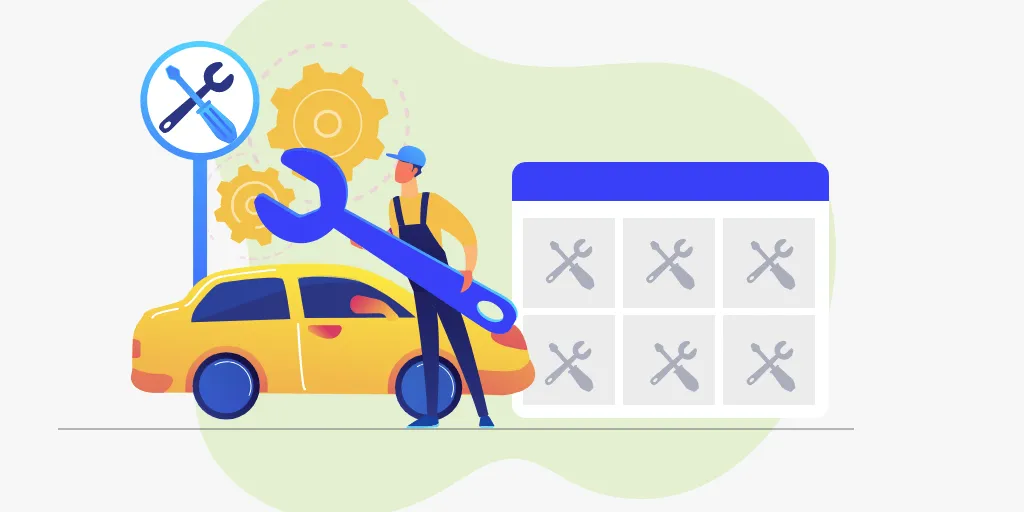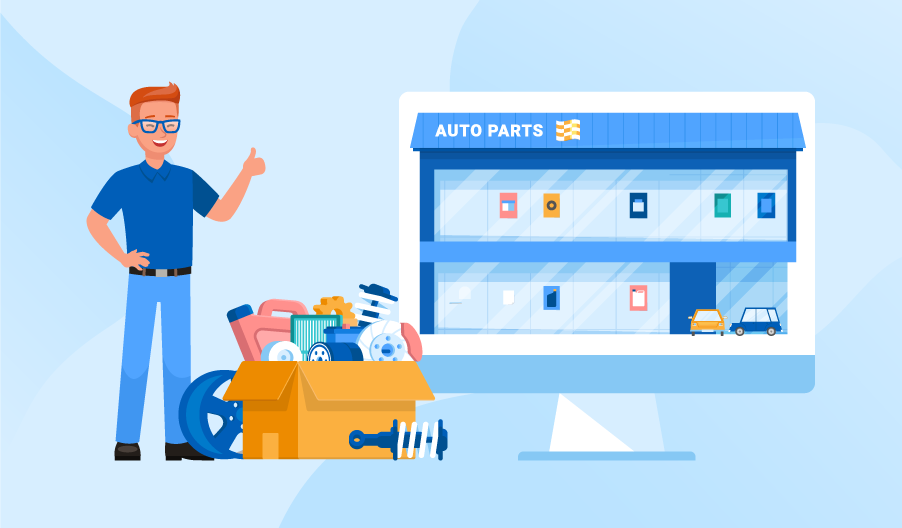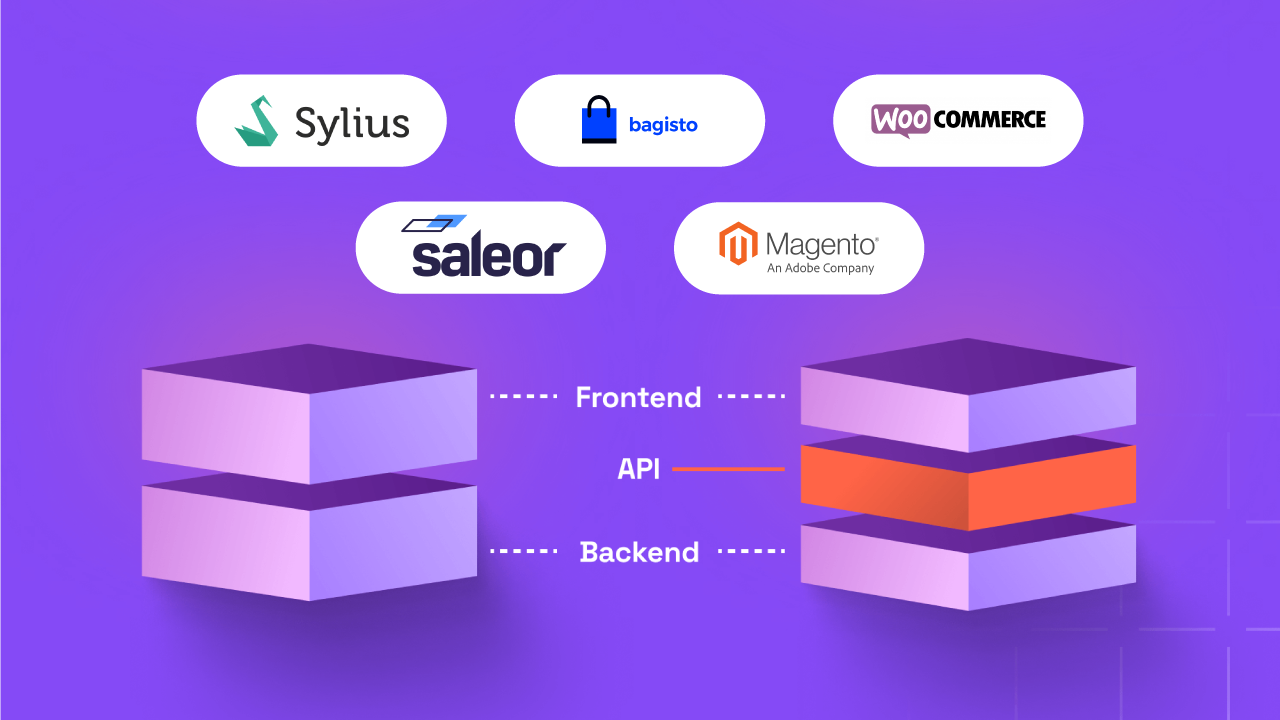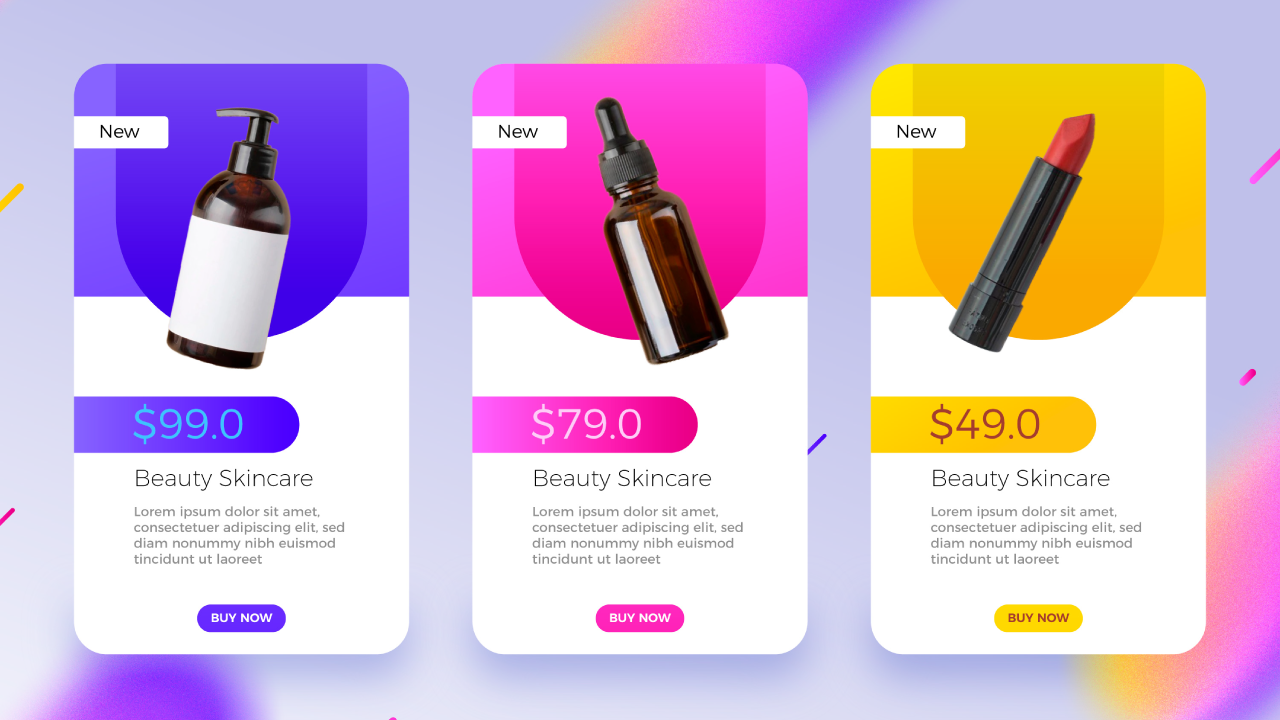How To Sell Auto Parts Online – The Ultimate Guide to Automotive eCommerce

The automotive aftermarket industry presents a huge opportunity for entrepreneurs who are already in the automotive industry or those who are looking for a good business opportunity to invest in. This post will present the case for automotive eCommerce and will guide you step-by-step on how to sell auto parts online.
Whether you’re already selling auto parts or thinking to step in this promising industry, there are plenty of growth opportunities you can capture.
Let’s drop some numbers here to create our case for automotive parts business before we walk you through the nitty-gritty of how to sell auto parts online.
Even when the world economy took a hit from the COVID pandemic, the automotive aftermarket industry continued to grow and revenues for auto parts retail reached $50 billion in 2020. This includes consumer sales only, no B2B revenue.
As far as eCommerce sales of auto parts is concerned, it is projected to hit $22 billion by 2023. The pandemic has shifted more revenues online as brick-and-mortar stores shut down and consumers increasingly prefer to buy online.
Read this post on how the pandemic spurred on the growth of B2B eCommerce.
The Big Opportunity in Selling Auto Parts Online
The automotive aftermarket industry is under a massive digital influence as consumers increasingly turn to online channels for research purposes before buying their auto parts.
These consumers watch YouTube videos, compare parts prices online, read reviews, and search for technical information on Google and Bing.
The McKinsey report identified digitization as one of the six main disruptions in the automotive aftermarket industry that will positively affect revenues for businesses that are prepared to capture the opportunity.
The case for automotive aftermarket eCommerce has already been made. Are you ready to step in the exciting world of eCommerce and unleash the growth opportunities?
This detailed guide will take you step-by-step through the process of creating an online auto parts store and some effective marketing strategies to get the most out of your eCommerce channel.
How to Sell Auto Parts Online: Analyze Your Requirements for an Automotive Parts Online Store
When talking to an eCommerce development agency, you’ll need to communicate your requirements clearly. This is important for getting an accurate quote for the project.
Before creating that requirements document, analyze your business model. Consider the critical aspects of your business before getting into the nitty-gritty of creating an online store.
What Products Do You Sell?
The first thing you need to consider is the kind of products you want to sell in your online channel. You may be operating your business in a broad category but considering to go niche in your eCommerce channel.
In any case, think about the kind of products you want to sell online. And then consider their packing and fulfillment requirements. Do they have any special shipping requirements?
For example, if you want to sell bulky parts like bumpers, grills, or hubcaps, you’d need shipping boxes that are big enough for these parts and find a shipping company that can ship products like these.
Small parts like spark plugs, cylinders, transmissions, and tools like wrenches and jack are more fragile. And so, they need to be packed appropriately to be shipped securely and safely.
What Types of Shipping Options Would Work for You?
Considering the products you sell, and the kind of customers you want to target, you will then think about the shipping options you’ll need to offer.
Which shipping company would work for you? What will be the cost of shipping? Will it work for you to allow users to pick up the auto parts from your store?
In what radius are you going to operate?
What Kind of Audience Do You Serve or Wish To Serve?
This is perhaps the most important question that will impact the user experience of your online auto parts store.
There are basically two kinds of people you can serve: consumers and other automotive businesses. Let’s discuss these two different kinds of audiences separately.
Consumers:
An example of a consumer is a car enthusiast who wants to install some car part to upgrade and improve the car’s performance.
Another example is a car owner who is looking for an auto part to repair his own car.
Other Automotive Businesses:
An example is an auto repair workshop where technicians need to stock up with auto parts to provide repair service.
The good thing is, both these markets are very lucrative to target. And fortunately, you don’t have to choose between them. You can easily create an online store that serves both these different kinds of people.
However, it gets a bit complicated when serving both of them. Selling to consumers is very different from selling to other businesses. B2B requires a higher budget and a more targeted solution that caters to the unique needs of both audiences.
What Does your Customer’s Buying Process Look Like?
Next, when you’ve analyzed your products, shipping requirements, and the audience you want to serve, you should then consider what your customers’ buying process and your own selling processes look like.
Do your customers often place bulk orders or parts in large quantities?
What payment options do your customers prefer?
How do your customers search for their auto parts? Do they need to filter the products based on details like car type, wheel type, model, etc.
What works best for your customers?
Keep in mind that customer experience will be the sole differentiator for your business. Hence, you need to handle this process really well.
Optimize the experience for your customers so they can place their trust on you and are even ready to buy for a slightly higher price.
How to Sell Auto Parts Online: Where Can You Sell Car Parts?

There are plenty of online channels to sell your auto parts, which means you’re not limited to your own eCommerce channel.
And luckily, you don’t even have to choose between them as you can sell on all these different platforms.
Some of the most popular channels for selling auto parts online are:
Your Own Online Store
No matter how many other online channels you’re selling car parts on, you should most definitely get your own eCommerce store as well apart from those.
The reason is simple, your own online store is like having your own place to call home. No matter how much revenue you generate from other places like Amazon and eBay, you don’t own those channels. You don’t even own the customers that buy from you from those other channels.
They are Amazon’s and eBay’s customers, not yours. If they choose to cut you out for any reason, you won’t have any access to the customers you acquired from there.
And so, you need your own online store where you can run marketing campaigns of your own and acquire your own customers.
Amazon
Amazon continues to lead the pack in eCommerce sales of auto parts with revenues from auto parts and OEM sales reaching around $10 billion in 2020.
eBay
Sales of auto parts on eBay were between $6 – $7 billion in 2020. eBay also provides some intuitive tools for auto parts sellers to sell parts online. It has around 90 million active listings of auto parts with around 3 auto parts or accessories sold each second.
How to Sell Auto Parts Online: The Features You Need
Following an analysis of all of the above, you can then create a Requirements Document. Make sure to jot down every feature you need to optimizes the user experience of your customer.
Easy Navigation
Most auto parts online stores have bulky catalogs consisting of thousands of products that fall in several different categories and taxonomies.
You need to look at your product catalog and break down your products in categories that make sense for you and your customer.
For example, if you only sell wheel accessories for different car brands and models, it would make sense to create taxonomies broken down by car type and car model so the customer can easily navigate and find the product he needs.
If you have a huge catalog that consists of every type of car part, it would make sense if you broke up your categories in say external parts, internal parts, engine parts, wheel parts, etc.
Fast Speed
Whether you’re selling B2B or B2C, your site needs to load fast on both desktop and mobile. This is critical for increasing your conversion rate and reducing the bounce rate.
Advanced Filters
This is especially required for automotive parts wholesalers that have bulky catalogs. You need advanced search and filter functionality that allows users to filter through your catalog easily and find the exact product without navigating through the entire catalog trying to hunt down a part they need.
Intuitive Search Functionality
A search bar with auto complete and instant search results feature works wonders for automotive eCommerce sites.
With this feature in place, the customer doesn’t have to type in the exact name and specification of the part. They can get suggestions as they type and they can even get a Quick View of the product right from the search result with an option to add the product to the cart – right from the search bar.
This feature especially optimizes the experience for B2B return buyers who know what they are looking for and just need a quick way to place the order for their parts.
Multiple Product Displays
For a catalog like auto parts, one size doesn’t fit all. You need to consider the different types of users visiting your site and cater to their differing needs by presenting your products in the most optimal way.
For example, a new user may require a detailed product view with high quality images and detailed product information.
A return or experienced auto parts buyer, on the other hand, may find the grid view of products less optimal and prefer the list view instead.
Check out the Product Table plugin if you want to add this feature to your site.
Quick Orders for Bulk Buyers
You need to provide a way for B2B bulk buyers to place their orders quickly. A CSV upload feature allows buyers to place a bulk order of auto parts with one click. This can really optimize the experience for B2B buyers.
Learn how to create a bulk order form on your online store.
Chatbots
A well-configured chatbot is a must-have feature for all eCommerce sites. It should be right there on every page of your store so your customer can easily get the information they need without wasting a second.
Loyalty Program
Everyone loves discounts. Whether you’re selling B2B or B2C, a loyalty program that is in sync with your referral program will help to drive sales on your eCommerce site.
Read this article on how to implement a referral system on your eCommerce store.
Price Gating
Because of several reasons, many automotive parts suppliers who sell to other businesses hide their pricing. If you’re one of those and want to show custom pricing, pre-negotiated prices, or offer prices only on request, you’ll need a feature called Price Gating.
With this feature, your prices will only be visible to the user once he’s logged in.
Other features can be installed too, like a signup form for example, with an approval process that takes a new user to the signup form when they want to access pricing.
Check out the B2B eCommerce for WooCommerce plugin to add this functionality to your online store.
Bulk Discounts
Bulk discounts or bundle discounts can be a valuable feature for an auto parts store for both B2C and B2B users.
Variation Tables
Auto parts come in different variations and your buyers should be able to place orders for multiple variations of the same products from one single product page. The default product page functionalities on most eCommerce platforms allow users to only add one variation in their cart.
And so, you’ll need a custom feature – either from a plugin or custom development – that allows buyers to add multiple variations at once. This feature can be especially important for B2B buyers. The Wholesale Product Page Customizer plugin lets you do exactly that.
Integrations
Finally, you’ll need your store integrated with several other systems you already have in place. If you’re using an ERP software, marketing software, or CRM, you’ll need those integrated with your online store so you can get all your data synced with each other. For this, you’ll need to reach out a custom software development agency.
How to Sell Auto Parts Online: Budgeting For Your Automotive eCommerce Channel
The next step in creating your online auto parts store is to create an eCommerce budget so you can approach your project accordingly.
If you move forward without a clear budget and attempt to create the most comprehensive website on the first go that boasts every feature you like, it can literally break your bank.
A good strategy is to make an eCommerce budget and approach your project using an agile method. So, if your budget doesn’t allow for a full-fledged online store, you can go ahead and create an online, web-based catalog that allows users to at least search and find parts, which they can pick up from your retail store.
White Knight Wheel Accessories did something similar. Instead of creating a full-fledged eCommerce channel, they took the first move and developed a web-based, fully searchable, and filterable product catalog on their website. Read their full story here.
How to Sell Auto Parts Online: Which eCommerce Platform to Choose
After you’ve done all of the above, the next step is to pick and choose an eCommerce platform to create your online auto parts store.
In this post, we’ll talk about the four most common eCommerce platforms recommended for B2B portals.
- Shopify Plus
- BigCommerce
- WooCommerce
Shopify Plus
Shopify Plus is a SaaS eCommerce platform, specially built for established companies that are making at least $10,000 in monthly revenue. It’s a closed, fully managed, in-the-cloud platform that frees you from the hassle of website management.
Shopify Plus offers many built-in features for wholesale businesses, right off the bat. This includes features like:
- Password-protected storefronts
- Fully customizable price-lists
- Minimum and maximum orders
- Third-party platform integrations
- Flexible payment and negotiation options for customers
- Bulk Account Inviter that sends an invite to all contacts in your email account to create an account on your new B2B store built on Shopify Plus
- Personalized Shipping Rates
- Faster Checkouts
- Global Exchange that allows you to do business with customers all over the world
- Checkout Customization options
- Shopify Flow allows you to tailor your shop’s landing page to personalize it for individual customers
However, Shopify Plus is quite expensive and won’t be worth your investment unless you’re making at least $10,000 in monthly revenue.
Read this Shopify vs WooCommerce comparison.
BigCommerce
BigCommerce is another popular option for building a B2B eCommerce portal. And like Shopify, BigCommerce is also a SaaS eCommerce platform and offers a fully-managed, open-platform solution that offers many B2B specific features.
BigCommerce is trusted by around 60,000 brands including industry-leading companies like Sony, Toyota, and Ben & Jerry’s.
By partnering with industry-leading technology providers, BigCommerce for B2B allows automotive store owners to dial-in the right eCommerce capabilities required for a successful B2B eCommerce venture.
Here are some technology providers BigCommerce has aligned with:
- Apruve
- Brightpearl
- PunchOut2Go
- BundleB2B
- Nextopia
- Shipper HQ
WooCommerce
WooCommerce is an open-source, self-hosted eCommerce platform for the WordPress CMS.
It is incredibly popular in the B2C sphere but is WooCommerce suitable for the needs and demands of B2B?
Open-source and self-hosted are the keywords here. These two keywords translate directly to higher flexibility. This means you can build anything on WooCommerce by paying for expert WooCommerce development services.
Luckily, many WooCommerce developers already saw this demand and have built a range of plugins and extensions that can be installed to add B2B-specific features required to roll out a seamless wholesale shopping experience.
And so, this means you don’t even have to pay for expert development services when building your online auto parts store using WooCommerce. You can use those off-the-shelf plugins and create your online B2B store.
Ready to take your first step in the digital world of automotive aftermarket?
We’ve 8+ years of expertise in eCommerce development in both B2B and B2C. Let’s talk about your automotive business requirements today!
Read also:




